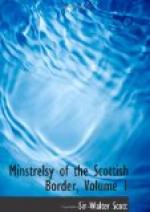Sir William Mautlant, or Maitland, the eldest and sole surviving son of Sir Richard, ratified and confirmed, to the monks of Dryburgh, “Omnes terras quas Dominus Ricardus de Mautlant pater suus fecit dictis monachis in territorio suo de Thirlestane,” Sir William is supposed to have died about 1315.—Crawford’s Peerage.
Such were the heroes of the ballad. The castle of Thirlestane is situated upon the Leader, near the town of Lauder. Whether the present building, which was erected by Chancellor Maitland, and improved by the Duke of Lauderdale, occupies the site of the ancient castle, I do not know; but it still merits the epithet of a “darksome house.” I find no notice of the siege in history; but there is nothing improbable in supposing, that the castle, during the stormy period of the Baliol wars, may have held out against the English. The creation of a nephew of Edward I., for the pleasure of slaying him by the hand of young Maitland, is a poetical licence[88]; and may induce us to place the date of the composition about the reign of David II., or of his successor, when the real exploits of Maitland, and his sons, were in some degree obscured, as well as magnified, by the lapse of time. The inveterate hatred against the English, founded upon the usurpation of Edward I., glows in every line of the ballad.
[Footnote 88: Such liberties with the genealogy of monarchs were common to romancers. Henry the Minstrel makes Wallace slay more than one of King Edward’s nephews; and Johnie Armstrong claims the merit of slaying a sister’s son of Henry VIII.]
Auld Maitland is placed, by Gawain Douglas, bishop of Dunkeld, among the popular heroes of romance, in his allegorical Palice of Honour[89]:
[Footnote 89: It is impossible to pass over this curious list of Scottish romances without a note; to do any justice to the subject would require an essay.—Raf Coilyear is said to have been printed by Lekprevik, in 1572; but no copy of the edition is known to exist, and the hero is forgotten, even by popular tradition.
John the Reif, as well as the former personage, is mentioned by Dunbar, in one of his poems, where he stiles mean persons,
Kyne of Rauf Colyard, and Johne the Reif.
They seem to have been robbers: Lord Hailes conjectured John the Reif to be the same with Johnie Armstrong; but, surely, not with his usual accuracy; for the Palice of Honour was printed twenty-eight years before Johnie’s execution. John the Reif is mentioned by Lindesay, in his tragedy of Cardinal Beatoun.
—disagysit, like John the Raif, he geid.—
Cowkilbeis Sow is a strange legend in the Bannatyne MSS.—See Complaynt of Scotland, p. 131.
How the wren came out of Ailsay.—The wren, I know not why, is often celebrated in Scottish song. The testament of the wren is still sung by the children, beginning,




